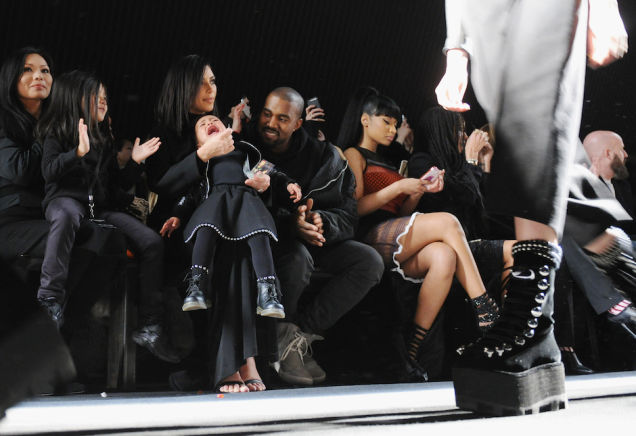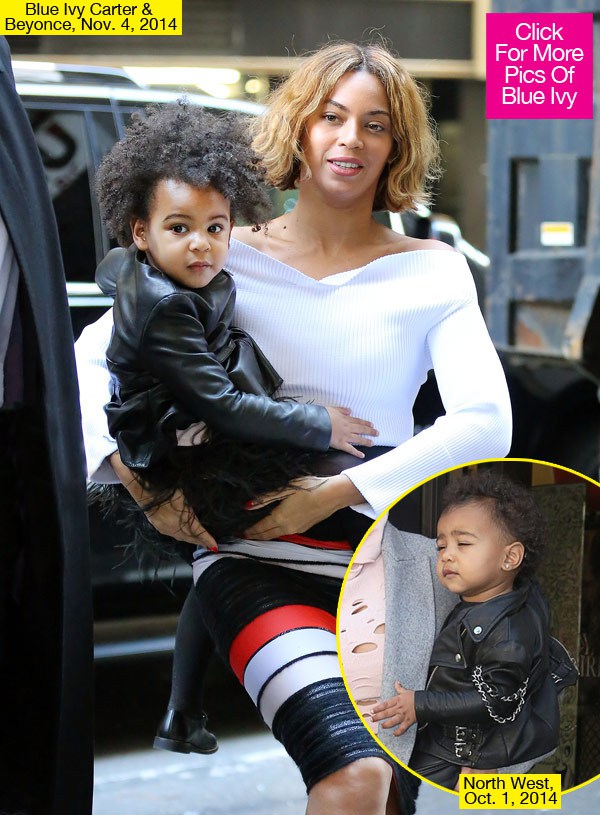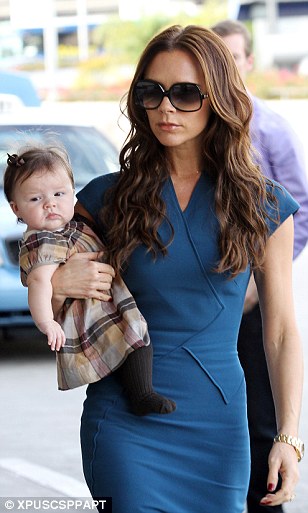"Most Adorable Accessory": Celebrity Kid Fashion
Apparently, Kim Karshasian and Kanye West dragged their toddler to Fashion Week. The dubious wisdom of doing such a thing is beyond the scope of this post—North West’s misery has already been catalogued.

Image Credit: Gawker
That face. More pertinent, I think, is the public investment in North’s attire. There’s some kind of fixation on celebrity-spawn, one that I think would be tedious to catalogue, so I’ll just leave some names here: Apple Martin, Harper Beckham, Blue Ivy, John Jolie-Pitt, and so on. If you’re like me, even your most desperate attempts to insulate yourself from the spectacle of celebrity children have not shielded you from the court-of-public-opinion’s rulings on these kids’ names, their gender identifications, and—perhaps because the critiques seem harmless?—their clothes.
For example, we’ve got this article that assesses Blue Ivy’s and North West’s similar jackets:

Image Credit: Hollywood Life
The image juxtaposes the girls’ jackets as if A) these toddlers had any kind of say whatsoever in their wardrobe, and B) they care about what a connection we, the viewer, make between their jackets. If you read that article, let me know whether our fashion judgment is meant to be ironic or not. Either way, some people have taken this impulse seriously. The comments sections of all of these “news” articles about North West all feature comments critiquing the parents for “not dressing their children like children” or for advertising with their kids’ clothing.
Actually, the way children have been trussed up and displayed has quite the legacy. In her book Pictures of Innocence, for example, Anne Higgonet details the nineteenth-century fascination with Little Lord Fauntleroy fashion (see chapter 2). Even for eras before the nineteenth century, children’s fashion has been used as a rubric for examining ideas about childhood and family. In his hotly-debated monograph Centuries of Childhood, for example, Phillippe Aries famously claims that medieval childhood did not exist—largely by illustrating that children in medieval art are often figured in adult dress.
In each of these cases, there’s an assumption that the external packaging of the childhood reflects the state of childhood itself. Okay, so maybe this idea isn’t actually revelatory. The entire underwear ad imagery that I touched on briefly last week certainly suggests that there’s a connection between presentation and reality. Still, it seems like the use of clothes has gotten a privileged place as a determinant of a child’s status. John Jolie-Pitt wears suits, so his parents must be liberal thinkers; Harper Beckham wears beautiful dresses; she must be an angel.
What’s so intriguing about all of these photos, to me, is that the children not only do not have a say in their attire—they are visibly performing that lack of agency. In the image I began with, for example, North is attempting to squirm out of Kim Kardashian’s arms. And here, Harper Beckham looks more like a doll than a human child:

Image Credit: Daily Mail
So, while these clothes are being used to facilitate judgment on celebrity parenting, they’re also being used as markers of the child’s status—not just socioeconomic status, but mental health status. I feel like we all need to read James Kincaid’s Erotic Innocence, in which he claims that children, by coming to be identified as markers of sheer innocence, actually become repositories for eroticism. I’m thinking, then, that these pop-cultural comments on children’s attire actually strangely echo this academic conundrum of the relationship between innocence and fashion—one that often leaves the agency of children in a sort of limbo. In emphasizing the way the children appear as the only reliable way of determining their status—and in deciding that we, the observer, are responsible for that determination, we’ve actually sort of mimicked the Victorian move of emptying children of their thoughts, feelings, needs, and wants, and filling them up with our own judgments, beliefs, and fantasies of them.
Now. Who wants to put that in the comment boards of Gawker?



Add new comment